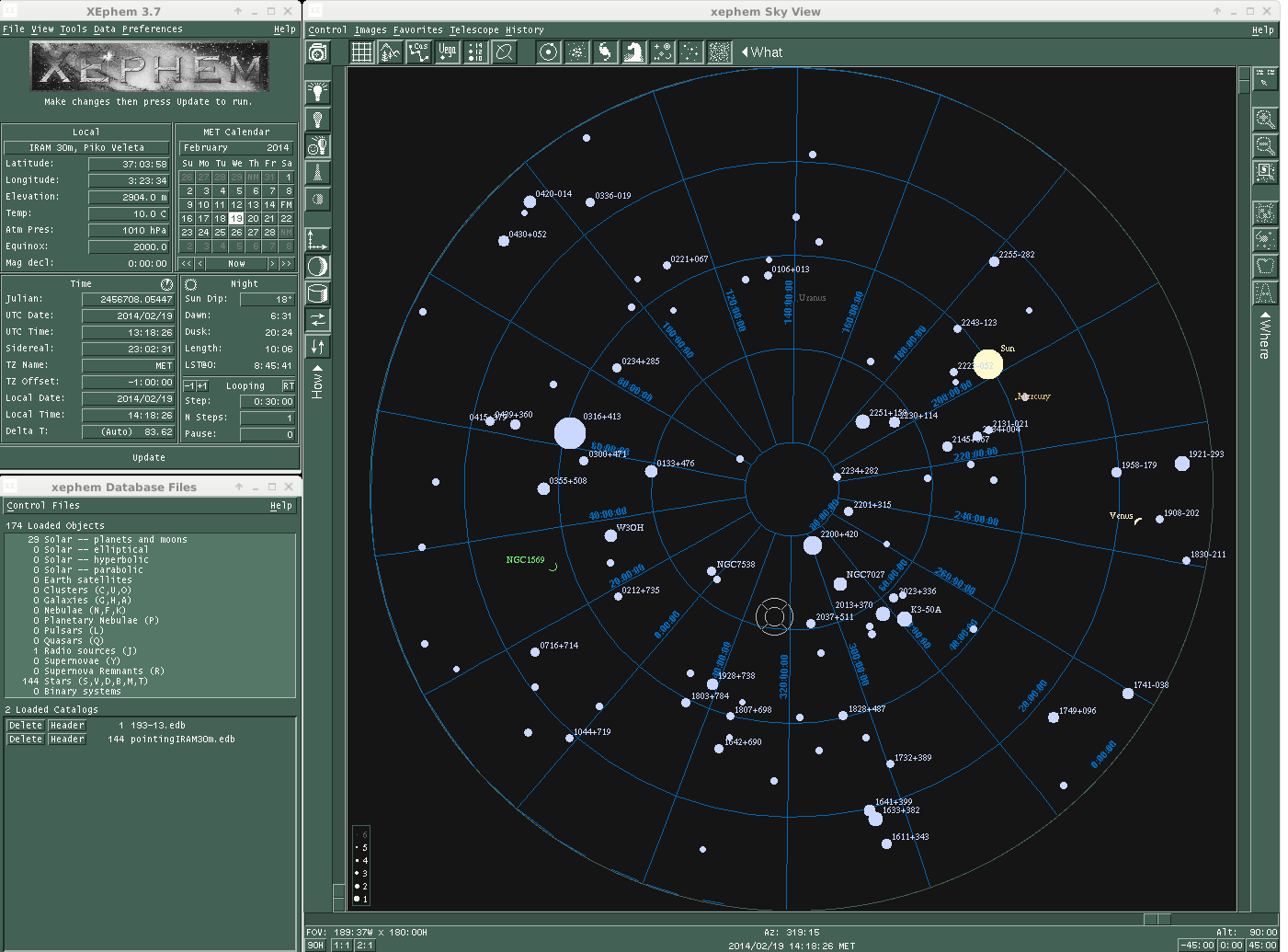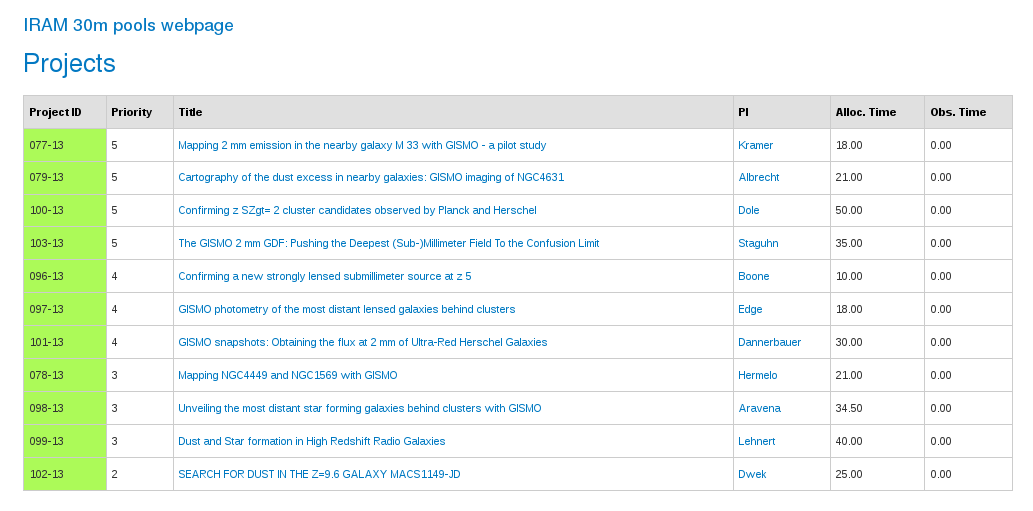|
Size: 7390
Comment:
|
Size: 7280
Comment:
|
| Deletions are marked like this. | Additions are marked like this. |
| Line 3: | Line 3: |
| = Observing session = Observations are carried from a dedicated pool account (ask the AoD for the login information). Each project has a folder within the home directory of the pool account with instructions on how to proceed. Read carefully the README file before to start. For example, the file [[attachment:README_199-14.txt | ~/199-14/README_199-14.txt ]] explains you how to observe the project 199-14. |
= Observing with NIKA2 = |
| Line 26: | Line 20: |
| ---- | == Observations queue == Open a terminal and type: {{{ $ ssh -X mrt-lx1 $ observationQueue }}} This will open a file browser with a list of all the jobs commanded. The display is automatically refreshed. Right-click to delete a job. ## Check the [[https://mrt-lx1.iram.es/mainWiki/NcsUG | NCS user guide wiki]] for more obs* commands. |
| Line 44: | Line 53: |
| ---- | |
| Line 66: | Line 74: |
| ---- |
|
| Line 71: | Line 77: |
| Choose a nearby quasar as pointing and focus source (using e.g. XEphem): | To correct the pointing of the telescope in a given part of the sky choose a nearby pointing source (using e.g. XEphem) and type: |
| Line 77: | Line 83: |
| Launch the '''nkpoint''' script: | Now launch the '''nkpoint''' script: |
| Line 83: | Line 89: |
| where the keyword mode can adopt the values '''b''' for bright sources, '''f''' for faint sources or '''l''' for very faint sources that require the Lissajous pattern. | where the keyword "mode" can adopt the values '''b''' for bright sources, '''f''' for faint sources or '''l''' for very faint sources that require the Lissajous pattern. |
| Line 90: | Line 96: |
---- |
|
| Line 104: | Line 108: |
| where the keyword axis can adopt the values X, Y or Z (i.e., the three axes of the subreflector). | where the keyword "axis" can adopt the values X, Y or Z (i.e., the three axes of the subreflector). |
| Line 112: | Line 116: |
| Now the telescope is pointed and focused, and ready to start to observe. ---- |
|
| Line 124: | Line 124: |
| ---- | |
| Line 133: | Line 132: |
---- |
|
| Line 152: | Line 149: |
| Line 153: | Line 151: |
| To launch this script just type: {{{ PAKO> @~/193-13/observe_NGC4449 }}} ---- == Choose a project == |
---- == Pool observations == Pool observations are carried from a dedicated pool account (ask the AoD for the login information). Each project has a folder within the home directory of the pool account with instructions on how to proceed. Read carefully the README file before to start. For example, the file [[attachment:README_199-14.txt | ~/199-14/README_199-14.txt ]] explains you how to observe the project 199-14. === Choose a project === |
| Line 183: | Line 183: |
| ---- == Project setup == |
=== Project setup === |
| Line 201: | Line 200: |
| ---- == Job queue of observations == Open a terminal and type: {{{ $ ssh -X mrt-lx1 $ observationQueue }}} This will open a file browser with a list of all jobs. The display is automatically refreshed. Right-click to delete a job. ## Check the [[https://mrt-lx1.iram.es/mainWiki/NcsUG | NCS user guide wiki]] for more obs* commands. ---- == Catalog of sources == |
=== Catalog of sources === |
Observing with NIKA2
Contents
Go to the NIKA2 main page.
Starting PaKo
Log into the pool account (ask the AoD/operator for the login information), open a terminal and type:
$ ssh -X mrt-lx1 $ goNIKA
Observations queue
Open a terminal and type:
$ ssh -X mrt-lx1 $ observationQueue
This will open a file browser with a list of all the jobs commanded. The display is automatically refreshed. Right-click to delete a job.
Starting the NIKA2 pipeline
Open a terminal and type:
$ ssh -X observer@nika2-a (ask the AoD for the password) $ IDL IDL> auto_nk_rta
It is also possible to reduce the scans manually:
IDL> nk_rta, scanID (e.g. '20151019s132')
Starting XEphem
Open a terminal and type:
$ ssh -X mrt-lx3 $ useNCS $ azElToXephem.py & $ xephem &
Click on the tab "View" and open the "Sky View". The "cross hair" shows the coordinates the telescope is pointing at. The filled blue circles are the pointing sources. The size of the circle is proportional to the flux of the target. Click on the tab "Data" and go to "Files". In the new window go again to "Files" and load the catalog of the project that you are observing.

Pointing
To correct the pointing of the telescope in a given part of the sky choose a nearby pointing source (using e.g. XEphem) and type:
PAKO> source 0133+476 /cat iram-J2000.sou
Now launch the nkpoint script:
PAKO> @ nkpoint mode
where the keyword "mode" can adopt the values b for bright sources, f for faint sources or l for very faint sources that require the Lissajous pattern.
Once the pointing is finished, enter the new pointing corrections:
PAKO> set pointing PnewX PnewY
Focus
The focus needs to be monitored and it needs to be corrected online! This should be done every three hours or so in the Z direction and every 24 hours in the X and Y direction. To check the quality of the focus, type:
PAKO> @ focusliss axis
where the keyword "axis" can adopt the values X, Y or Z (i.e., the three axes of the subreflector).
Once the focus is finisihed, enter the new focus value:
PAKO> set focus Fnew /dir axis
Beam map (needs to be updated once we have an standard procedure)
The beam map consists in 3 ?'x?' maps with ~?" steps between rows and a duration ~?? minutes. Beam maps are designed to ensure the source is moved over all the detectors of the array, in order to characterize and calibrate them (field of view geometry, flat field, stability...). The aim is to calculate the actual pixel offsets in the focal plane (see figure below). To obtain a beam map go to a primary calibrator and launch the beammap.pako script:
PAKO> @ beammap
Skydips (needs to be updated once we have an standard procedure)
To run a skydip with NIKA type in PaKo:
PAKO> @ skydip_DYI
Science targets
Observations of science targets are performed via on-the-fly and/or Lissajous maps. For example, for a 16'x12' on-the-fly map, with a position angle of 25 degrees, a tilt angle of 0 degrees (both measured anticlockwise), in equatorial coordinates (radec), just type:
PAKO> @ nkotf 16 12 25 0 radec
For a 3'x3' Lissajous type:
PAKO> @ nkliss 3
A sequence of several scans can be loaded using scripts.
For example, the script observe_NGC4449.pako combines several 14'x14' on-the-fly maps at different angles in the horizontal coordinate system (azel).
Pool observations
Pool observations are carried from a dedicated pool account (ask the AoD for the login information). Each project has a folder within the home directory of the pool account with instructions on how to proceed. Read carefully the README file before to start. For example, the file ~/199-14/README_199-14.txt explains you how to observe the project 199-14.
Choose a project
First log into the Pool data base (ask the AoD for the login information) and click on the GISMO/NIKA tab.

Projects have different priorities from 6 (highest priority) to 1 (lowest priority). Green color indicates that the project is scheduled, orange that the project is on hold, and red that the project is finished. Only green projects should be observed. To check the visibility of these projects go to the visibility tab:

The red vertical line corresponds to the current time (UT). In this example there are four priority 5 projects. Project 077-13 is not visible at the current time. Project 079-13 is close to the low elevation limit so it is a bad option. Since project 103-13 sets first, it is a good idea to observe this project. After 2-3 hours change to project 100-13. In case that none of the priority 5 projects have weather requirements (see the README files) compatible with the current conditions, go for priority 4 projects and so on.
Project setup
The standard method to set the project is:
PAKO> set project XXX-YY
However, for pooled observations this is often done using a setup script (see for example setup_199-14.pako). For example, before to start to observe the project 199-14 you should type:
PAKO> @ ~/199-14/setup_199-14.pako
It is IMPORTANT to set the project accordingly before each observation in order to identify the scans observed for each project, keep control on the time used to observe each project, and write the data files in the right directory. When you will be doing tests, or if you have to stop by wind, or whatever, just type "set project test". That way, no project will loose time due to technical problems, or bad weather.
Catalog of sources
Before to start to observe a certain project it is necessary to load its catalog of sources. Usually, this is automatically done within the setup script. If for some reason you need to load the catalog manually, type:
PAKO> SOURCE CATALOG 199-14.sou
This command will load the catalog 199-14.sou with the position of NGC4449: To select this source, just type:
PAKO> source NGC4449
To select a source from the IRAM catalog of pointing sources, just type:
PAKO> source pointing_source /cat iram-J2000.sou
Author: Israel Hermelo (Pool Manager of the IRAM 30m continuum cameras)
email: hermelo@iram.es
Created: 2013.OCT.25
Last update: 2015.OCT.19
